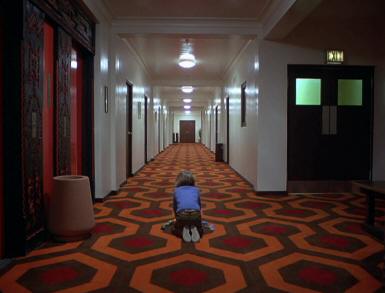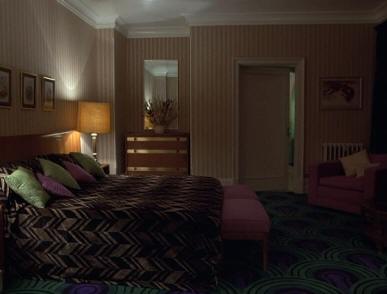CHAPTER THREE The multitude of cartoon and fairy tale references in The Shining tend to be missed or glossed over in most of the analysis / reviews that I’ve read. And it was only after a series of emails asking me about the meanings of specific cartoon related details that I finally took the theme seriously. Leaving analytical judgements aside, here is a list of obvious cartoon references in the film.
Now I’ll offer some interpretations of possible additional cartoon references in the film and how, in combination with the more obvious examples, they thematically affect the story. One of the most prominent conceptual uses of these cartoon symbols is that when the psychiatrist is questioning Danny on his bed, Wendy is wearing clothes that are virtually identical to those of the Goofy figure beneath the window – yellow boots, a red sweater and blue overalls (a blue dress for Wendy).
Shelley Duvall has big eyes and buck teeth, much like Goofy, and her sobbing in later scenes has a snorting quality similar to Goofy’s chuckle in the Disney cartoons. It’s possible that Kubrick merely noticed these aesthetic similarities to Shelley and played a prank on her in retaliation for their conflicts on the set, as witnessed in the behind-the-scenes documentary. Yet it’s also possible that he chose Shelley for the role with these Goofy-like similarities in mind. He may have even directed her to sob in a similar way to Goofy’s chuckling. My guess is that Kubrick knew in advance he would be encoding this character crossover and took this into account when casting. My primary reason for this assumption is because the Jack Torrance character not only spoke “Big bad wolf” dialogue in the film, but he is also unshaven with long hair … a visual manifestation of the “Big bad wolf”. The steadicam shots that follow Danny throughout the hotel and the maze also tie in with Danny representing the Roadrunner, who in the Looney Tunes cartoons was always chased by Wile E. Coyote, again represented by the wolf-like Jack Torrance. Just like in the Roadrunner cartoons, Jack gives chase to Danny the Roadrunner, but is outsmarted and fails to catch his prey.
The use of Roadrunner cartoon music when Wendy picks up the baseball bat in her apartment is heard from an off screen tv, but it thematically matches Wendy’s behaviour. So as not to frighten little Danny, she sneaks over to the couch, picks up the bat and then sneaks out of the apartment, while the music suggests mischievous tip-toeing. Another possible inclusion of cartoon or fairy tale symbology is the use of giant multi-coloured carpets in the hall outside room 237 and in the room 237 interior.
From what we see of the rest of the hotel, the colourful set designs are mostly based upon Native American art. Are the more child-like carpet designs related to Danny’s child-hood imagination? We’ll return to this in chapter six. The events that we see inside room 237 may also be a further reference to child hood imagination. The Hansel and Gretel fairy tale was already hinted at by Wendy’s comments in the kitchen about leaving “a trail of breadcrumbs”, and in room 237 we are presented with a mysterious female character who entices Jack with a sensual invitation, but then she turns into what may be a symbolic manifestation of the wicked woman from Hansel and Gretel, who herself lured the children in with candy before transforming into a witch. This could also explain the over the top colours and patterns of room 237 as being symbolic of the gingerbread house from the same fairy tale. These Hansel and Gretel parallels are not a conclusive interpretation, but they certainly fit.
It certainly appears that Kubrick infused The Shining with subliminal links to cartoons and fairy tales, and there are several possibilities as to why he would do this. One interpretation is that Kubrick was making a mockery of the surface horror story. Neither his films nor his rare interviews gave any indicators that he believed in the supernatural or the afterlife. He spoke and acted like a confirmed atheist. “I think the unconscious appeal of a ghost story, for instance, lies in its promise of immortality. If you can be frightened by a ghost story, then you must accept the possibility that supernatural beings exist. If they do, then there is more than just oblivion waiting beyond the grave.” – interview with Michael Ciment about The Shining One of the more frequent criticisms of The Shining is the over the top performance of Jack Nicholson in the latter half of the story. Jack’s murderous intents could have been made much more frightening if the scenes were played straight and the comedic lines dropped. Kubrick would certainly have known this and so it’s only logical that he intentionally had Nicholson ham up his performance to the point of silliness. Here is a quote from the editor who assisted Kubrick in cutting the film. “That long tracking shot where Jack Nicholson pursued Shelley Duvall up the staircase while she’s waving a baseball bat at him was taken fifty or sixty times. Typically, Nicholson’s first take would be absolutely brilliant. Then the thing would start to get stale after about ten takes. … the impression I got is that Stanley tended to go for the most eccentric and rather over-the-top ones. There were plenty of times when Stanley and I were viewing the stuff where my private choice of the best performance – or sometimes he would ask me – wasn’t in, while the more eccentric one was.” - Gordon Stainforth on editing The Shining, quoted from p317 Stanley Kubrick: A Biography by John Baxter This wasn’t the first time Kubrick had manipulated an actor’s performance to be over the top. He famously did the same thing with George C. Scott’s performance in Dr Stangelove. He would pacify Scott’s desire to give a skilled performance by allowing him to do a number of serious takes, then he would ask him to do a couple of outrageous takes just for the hell of it. Of course it was the latter takes that made in into the final cut. The other subliminal themes that will be presented in this analysis will further support the assertion that Kubrick was not drawn to The Shining by a desire to make a supernatural horror film. There are some genuinely disturbing sequences, but they are subliminally based around very real psychological devices, not the supernatural. In a nutshell, Kubrick mocked the ghost story and possession themes by transforming them into laughable cartoons and fairy tales at the subliminal level. |






